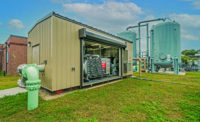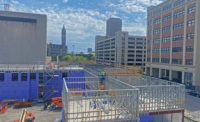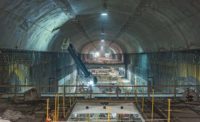Like those elsewhere, general contractors in ENR’s New York and New England regions suffered a drop in construction revenue in the year of the pandemic. But individual firms still managed positive financial results in 2020. The 50 largest contractors in New York and New Jersey on this year’s Top Contractors list reported combined revenue of $24.76 billion for 2020, down 8.6% from the 50 highest-ranking firms’ regional revenue of $27.1 billion in 2019. The top five firms together had regional revenue of $9.8 billion, a reduction of 22% from $12.6 billion reported in 2019.
Yet at least one contractor saw increased revenue in the New York region: Gilbane Building Co., which reported $1.56 billion last year , compared with $1.50 billion a year earlier (see page NYNE24 for a closer look at how the firm generated growth in 2020).
On the ENR New England rankings, Suffolk excelled despite the pandemic. The Boston-based contractor topped the chart for the fifth time in six years. The firm’s $1.69 billion in regional 2020 revenue essentially equaled its $1.7 billion total the previous year.
|
Related Links |
Overall, the 35 firms on this year’s New England ranking saw a modest 1.61% revenue decrease from those on last year’s ranking. This year’s listed firms posted a combined $12.2 billion in 2020 revenue from work performed in Connecticut, Maine, Massachusetts, New Hampshire, Rhode Island and Vermont. The top five firms this year reported a combined $5.9 billion in 2020 revenue, up 13.46% from the performance of the leading five the previous year.
To gain an industry outlook in the New England and New York regions, ENR spoke with executives from Turner Construction, AECOM Tishman, McAlpine Contracting and Consigli Building Group. Their thoughts have been edited for length and clarity.
How do you believe the Biden administration will impact design and construction?
Jay Badame, AECOM president of construction management and former AECOM Tishman president: President Joe Biden’s ambitious infrastructure proposal would be a game changer. Not only would it provide a boost to the design and construction sector, it would reshape the Northeast by stabilizing our physical infrastructure.
Jeff Navin, vice president of project management, Consigli: Biden’s infrastructure plan will support upgrading transportation, schools, hospitals, affordable housing and other facilities. There is also the push for net zero to consider. Clients are thinking about how to meet these carbon emission goals now in their design process.
Which sectors have offered the biggest opportunities?
Lisa Hickerson, manager of business development, greater New York, Turner: We are seeing retail shift toward industrial and warehousing. We will see higher education and health care institutions rebound as they require renovation and improvement to stay competitive. Infrastructure and affordable housing have seen large increases due to an influx of public monies. Life sciences are booming in New York City, Philadelphia and New Jersey due to the influx of venture capital funds, NIH grants and talent.
Carlos Torres, business development manager, New Jersey, Turner: The life sciences market also continues to thrive in Princeton and Bridgewater, given the proximity to New York and Philadelphia, the state’s leading colleges and universities and big pharmaceutical corporations. The industrial sector in New Jersey, which was already on fire before the pandemic, has continued to heat up as people become more accustomed to e-commerce.
John Nolan, vice president, McAlpine: In the New York, New Jersey and Connecticut tristate area, we see assisted and senior living and affordable housing as healthy markets. McAlpine’s portfolio of ongoing health care projects has been growing, including a freestanding, multispecialty clinic on Long Island, high-end dental facilities in Brooklyn and specialized veterinary clinics in Manhattan and New Jersey. We are forecasting several years of strong growth in the medical sector and have prepared to serve its specialized construction needs that include stringent wellness, disease control and safety procedures.
Badame: Health care construction was in high demand last year.
Which sectors have cooled down?
Hickerson: Retail’s decline in New York was further accelerated by the pandemic.
Torres: New Jersey’s commercial market has been cool, with commercial leasing activity dropping in the first quarter of 2021 for the second consecutive quarter to less than 1 million square feet. Vacancy rates of over 25% remain at the highest levels in more than eight years.
Nolan: The ground-up, market-rate, residential development segment has cooled down considerably, and we see it remaining on ice until the existing inventory in New York City is soaked up. Investors are currently shying away due to the recent increase in violent crime. However, the beginning migration of families from the suburbs back to the city might reverse this trend.
Badame: Commercial tower construction cooled down by necessity last year due to the pandemic.
What key innovations helped you boost productivity or other metrics?
Torres: Aside from virtual meetings, we’ve also used Miro, an online whiteboard tool, to hold virtual pull planning meetings, a key aspect of our lean approach to construction which helps to coordinate and schedule the activities on our projects. On some of our larger national projects, in using data from our trade partners’ weekly work plans and tools such as Power BI, we are able to develop interactive site plans that depict the density of planned work crews in various locations, allowing us to relocate them if necessary for a more productive and safer workflow.
Navin: We are seeing an increase in everything from volumetric multiroom modular to structural and exterior prefab systems in an effort to help speed to market and for cost efficiencies.
How do you think the industry is rebounding from COVID-19?
Hickerson: Projects that had been in planning prior to the pandemic seem to have picked back up. However, you can still sense the hesitation and concern of owners in pulling the trigger on new major projects, especially in the commercial, health care and higher ed sectors.
Torres: Many projects that were put on hold in 2020 in the sectors hit hardest—including commercial, health care, higher education, hospitality and aviation—have started to come back to life. Additionally, New Jersey’s new incentive program, the New Jersey Economic Recovery Act of 2020, is primed to stimulate market activity by helping to attract and retain businesses.
Nolan: I see a major rebound in retail and interior work in New York City as drawings and bid documents are pouring in, with commercial and institutional tenants planning to return to their spaces in the fall. A major difficulty caused by the pandemic is shortage of materials and building systems. Nearly all materials are now treated as long-lead items, with significantly increased pricing due to shortages. I expect material lead times and pricing to begin returning to pre-COVID levels in quarter four.
Badame: One of our biggest challenges will be adapting to new ways of delivering projects safely and being able to ramp down and ramp back up quickly.







Post a comment to this article
Report Abusive Comment